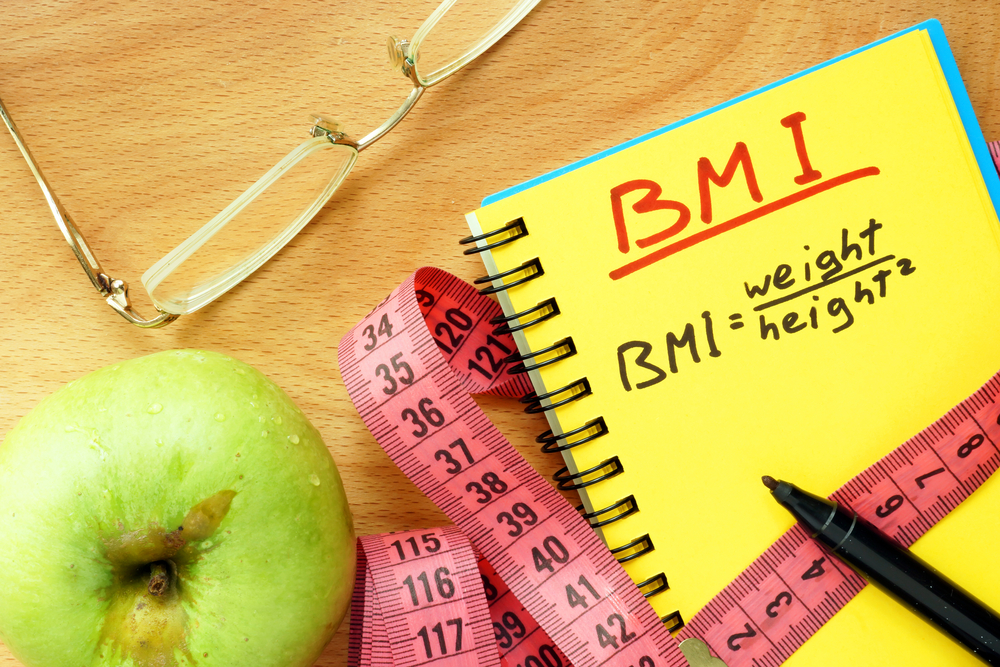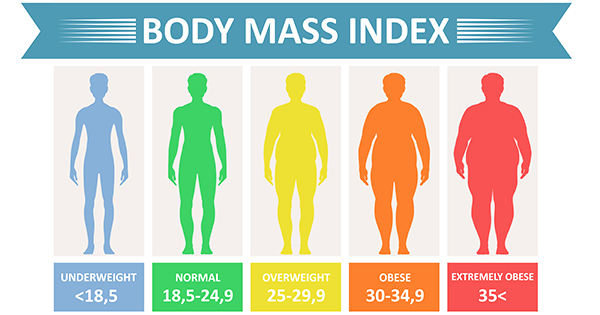The field of medicine is full of tons of complicated and confusing medical conditions. You have probably heard one of those terms — that the abbreviation BMI — through a doctor’s appointment or perhaps at the news.
You probably know BMI stands for body mass index and that it has to do with weight, but just what is BMI used for, and how badly do you need to consider your BMI and the BMI of your household?
Think of this as your detailed guide to all of the things BMI. Here, you will learn what BMI means; how to compute your number; exactly what a low, normal, or high BMI is; and why the measurement isn’t without its downsides.
What Is the Definition of BMI?
BMI is a frequent measure of body weight, and many medical professionals use BMI to categorize individuals as having a normal weight, being obese, or being overweight.
Using this strategy, the Centers for Disease Control and Prevention (CDC) estimates that more than one-third of American adults are overweight. The CDC also estimates that in 2008, obesity cost the United States $147 billion in healthcare that year. A person who’s obese paid $1,429 per year more than somebody with a regular weight, the CDC notes.
BMI may be tied to an own health risk for specific diseases and health outcomes, but the measurement is limited, some critics assert.
The CDC warns that BMI should not be used to specify body fat or diagnose health ailments. Instead, if you’ve got a high or low BMI, your doctor may have you experience additional health screenings, such as elevated cholesterol or high blood pressure.
Your BMI can also lead your company to put you in a high-risk group in terms of your health, possibly affecting your insurance rate.

What is a Healthy BMI in Adults? Why It Matters and How to Figure Your Number
According to the CDC, more than one-third of American adults are overweight, with that an April 2018 article in JAMA suggesting that amount is nearly 40 percent, meaning 90.3 million Americans.
Non-Hispanic black men and women are the most likely to be obese, followed closely by Hispanics, Caucasians, and non-Hispanic Asian people.
Middle-aged adults are at the best risk for the disorder, followed by elderly adults ages 60 and older, and young adults ages 20 to 39.
Overall, the South has the highest prevalence of obesity, while the West and Northeast have the lowest levels of obesity.
The Importance of a Healthy BMI
If you are an adult, maintaining a regular BMI is essential to your future health, since a high BMI was linked to an increased risk for ailments such as heart disease and type 2 diabetes.
In young adults, obesity may even be to blame for the increase in rates of colorectal, endometrial, gut, kidney, multiple myeloma, and pancreatic cancer, based on an analysis of information printed in February 2019 at The Lancet Public Health.
Calculating Your BMI
To calculate your BMI, take your weight in kilograms divided by the square of your height in meters.
If you live in the USA and do not use the metric system, you might even choose your height in inches squared, then divide that by your weight in pounds, and then multiply by 703.
By Way of Example, for a woman who is 140 pounds (lb) and 63 inches (in) tall, so we could compute her BMI this way:
- Height in inches squared: 63 x 63 = 3,969
- Weight divided by height squared: 140/3,969 = .03527
- .03527 x 703 = 24.79 BMI
If math isn’t your forte, you can elect to use that the CDC’s BMI calculator to work out your BMI.
What’s a Healthy BMI? A-List of those Ranges
Here’s what your number means:
- Below 18.5: underweight
- 18.5 to 24.9: normal
- 25 to 29.9: obese
- 30 and over: obese
Although BMI cutoffs are exactly the exact same regardless of sex and age, there are some differences. Generally, women of all ages generally get a higher body fat percentage compared with men the same age. Along with the older we are, the weight we carry is normally greater in human body fat and lower in muscle.
What a BMI Chart Looks Like
To determine whether your BMI is healthy, you can even examine the below chart, which specifies healthy, obese, and obese ranges according to your height and body weight in pounds.

What’s BMI Percentile? Why Your BMI in Kids Is Different From Calculating BMI in Adults
Children aren’t immune to the United States obesity epidemic. In fact, according to 2011–2014 CDC data, the latest data available, approximately 17 percent of children and teens ages two to 19 are considered obese or overweight.
Your behavior as a parent, in addition to your child’s community and geographical area, is closely connected to his or her obesity risk. The affordability of healthy food, the chance to be physically active in schools and daycare, and exposure to the advertising and promotion of healthful or unhealthy foods may also impact your child’s obesity threat.
How to Calculate Your Child’s BMI
Your kid’s pediatrician will often compute his or her BMI when he or she is about age 2 or 3. But rather than following BMI ranges for adults, doctors screen children, adolescents, and teenagers for obesity using what is called growth chart percentages, which use percentiles.
A kid between ages 2 and 18 is deemed overweight if the BMI is between the 85th and 94th percentile. A kid in the exact same age range is deemed obese if the BMI is at or greater than the 95th percentile.
Percentiles represent a child’s BMI relative to additional U.S. children who are the same sex and age. This strategy can help your doctor understand your child’s body weight and health dangers as their own bodies continue to grow and grow.
Steps to Help Decrease Your Child’s BMI
Weight loss is a sensitive subject irrespective of era, but for kids, this subject requires some extra attention to nurture your child’s psychological health. Having obesity might increase your child’s risk of depression, and children and adolescents that are overweight or obese could have a negative self-image, particularly if they are women, research suggests.
If your child should lower his or her BMI, think about approaching the issue by talking about lifestyle changes throughout the family unit rather than addressing your child’s weight loss straight. Doing so can help prevent damaging their self-esteem.
Healthy diet changes you may make as a household comprise a focus on lean protein, whole grains, vegetables, fruits, and low-fat dairy. Popular diets aren’t typically recommended but altering what kinds of foods that your child has access to is a good start. Do not restrain the amount your kid eats — that’s his or her selection. Your function is to control the kinds of alternatives out there.
Because weight loss necessitates taking in fewer calories than you burn, you can help your kid lower his or her BMI by encouraging more physical activity. But rather than telling your kid to get up and get some exercise, then invite her to play a group game like kickball or have a walk with you. Model the behaviors you want to see in your kids by spending some time being busy as a family.
How Your BMI May Affect Your Infection Risk and Longevity
If it comes to assessing the association between your BMI and your risk for disease or premature death, study results are mixed, with some suggesting that a higher BMI may at once increase your risk for negative health outcomes and also have a protective influence on your chances for survival.
What we know for certain, at least an observational level, is that BMI correlates with obesity-related states,” says Jessica Crandall, RDN, the general director of Denver Wellness and Nutrition Center–Sodexo at Colorado, and a national spokesperson for the Academy of Nutrition and Dietetics.
By Way of Example, a higher BMI is associated with an increased risk of:
- Type 2 diabetes
- Heart disorder
- Cancer
- Gallbladder disorder
- Depression
- Nonalcoholic fatty liver disease
- Arthritis
- Sleep apnea
A higher-than-normal bodyweight generally entails excess fat on the body, which is a simple cause of body systems bloated. An overproduction of fat cells results in an overproduction of blood glucose, hormones, a plaque from the blood vessels, and stress on bones and organs. Your system is overwhelmed and starts to do its best to balance itself out. Some folks may see a delay at the beginning of age-related disease because of their genetics.
A greater BMI’s marginally protective effect on survival is intriguing to note. Some research indicates that if you’re hospitalized for a chronic condition such as heart disease or cancer, having a higher BMI can provide a protective influence. This phenomenon is known as the “obesity paradox” and can be partly explained by the fact that extra muscle and weight may compensate for lost weight and muscle mass during acute illness, finally helping speed recovery.
What Are the Risk Factors for Having a High BMI?
A high BMI is connected to high body weight and excess body fat. Fat accumulates if the energy (calories) taken in through food is greater than the energy we burn through action.
A low intake of fruits and vegetables is associated with a greater body weight because the energy density of those foods is significantly lower compared to other foods. On the flip side, high fat and sugar intake are associated with a higher BMI because the grade of those foods is higher than that of fruits and veggies.
The total amount of your body moves into this energy balance equation. Individuals that are physically not able to exercise because of illness or injury, or who can’t move around safely in their own communities, may experience weight reduction. Also, having a desk job may lower your body’s energy needs, raising your risk of becoming overweight or obese. As mentioned, having a high BMI can take a toll on your health, so it is not surprising that the longer you sit and the less you go, the higher your risk for premature death and chronic disease, per an article published in November 2018 in JAMA.
How Do You Help Decrease Your BMI?
Remember that BMI is a calculation with your own weight and your height. Adults who must reduce their BMI must eliminate weight since their height is fixed.
You can assist lower your BMI by taking the next measures.
Make smart food choices. Several diets are at your disposal to assist you to take off extra pounds. However, in general, eating more low-carb, high-fiber foods like nonstarchy vegetables, veggies, beans, and whole grains is a tried-and-true method to help decrease your body fat loss.
The USDA Dietary Guidelines suggest that variety, nutrient density, and portion sizes are significant. For optimum health complete, limit added sugars, unhealthy fat, and sodium. Believe 10-10-2,300 for these food groups: additional sugars less than 10 percent of your total calorie consumption, saturated fat less than 10 percent, and sodium less than 2,300 milligrams (mg) daily.
Exercise regularly. The Office of Disease Prevention and Health Promotion recommends 150 moments of moderate-intensity aerobic physical action (for example, playing tennis or walking) per week or 75 minutes of vigorous-intensity aerobic physical activity (for example, biking, swimming, running, or jogging). For even more health benefits, you can increase your moderate-intensity workout to 300 minutes each week or your vigorous-intensity aerobic physical activity to 150 minutes.
Get sufficient sleep. Most adults need seven to nine hours of sleep. Chronic lack of sleep or poor sleep quality may increase your risk for poor health effects such as hypertension, cardiovascular disease, diabetes, depression, and obesity.
Handle stress well. Stress is not possible to avoid completely, rather than all stress is bad. But chronic pressure causes pressure on the body, which may increase your risk for obesity, higher blood pressure, heart disease, and type 2 diabetes, as well as mental disorders like anxiety and melancholy. Stress management tips include getting regular exercise; stressful meditation, yoga, or tai chi; locating emotional support through friends and family; and using an open conversation with your healthcare team about your psychological wellbeing.
Eat out less and cook at home. Eating at home typically causes a decrease in fat, sugar, and unhealthy processed carbohydrates. Create a realistic goal of eating a meal in the home just one or two times more than you do today. Keep the meals easy, and aim for at least three food groups per meal (such as whole grains, lean protein, and vegetables). A meal like a chicken breast with brown rice along with a side salad could be pulled together in less than half an hour.
Let’s face it: Losing weight is hard — and keeping it off is much tougher. Many people want that quick fix, which explains why fad diets that promise quick weight loss are so tempting. But the majority of men and women put on weight during a long period of time, so losing weight might take a while as well. Making gradual, practical adjustments to your diet and lifestyle can finally lead to the long-lasting results you are seeking.
Why BMI Is Not Perfect: What to Know About the Calculation’s Flaws
The simple fact that BMI paints a picture of just a portion of an individual’s health has drawn criticism from some health professionals. Though BMI requires your weight and height into account, it doesn’t consider other aspects that are known to influence disease risks, such as high blood pressure, blood sugar, and cholesterol.
“There is not only one data point” as it comes to assessing someone’s health risks, says Janice Baker, RD, CDE, the proprietor of Baker Nutrition in San Diego. She adds that it’s important for doctors to evaluate factors like muscle mass, activity level, and nutrition when deciding how healthy or unhealthy an individual is.
To measure body composition, a number of additional approaches may be more suitable than BMI, notes past research:
- Weight-to-height ratio
- Waist circumference
- Waist-to-hip ratio
- Body fat percent
The following attributes may mean BMI isn’t an effective tool for measuring your health dangers: (36,37,38)
- Being an athlete
- Becoming pregnant or pregnant
- Being over age 65
- Being Asian






